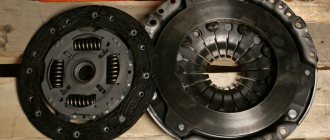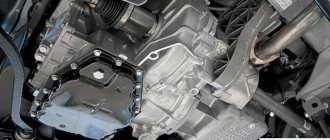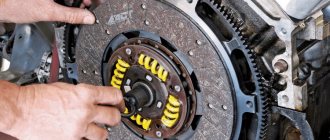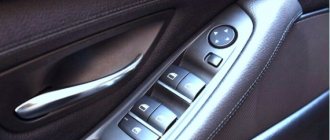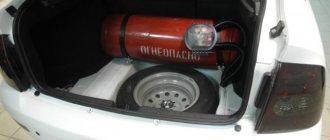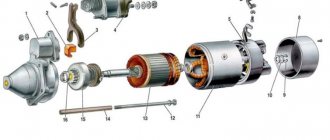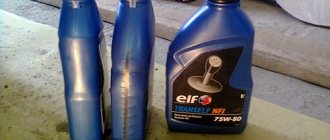With a working engine, an impeccable gearbox, and a new chassis, the car will not go anywhere without a clutch. On the Lada Vesta this is one of the most important components. The task of a mechanical clutch is to connect the internal combustion engine and manual transmission, transmitting torque from the engine to the chassis, and also to separate them when changing gears (if you leave the gearbox input shaft rotating through the internal combustion engine, the gears will inevitably be damaged).
The Lada Vesta clutch on a manual transmission (mechanical) consists of one disc, engagement is made mechanically (dry, permanently closed type), the drive is hydraulic. The latter means that the unit is driven by fluid pressure and is adjusted manually (by foot) by the driver. In addition, the fluid system acts as a pedal booster. After all, simply pressing with your foot is not enough to set in motion the structure, which engages with the shaft while rotating several thousand revolutions. Therefore, there is no need for hydraulics on an AMT. Read the article to the end and you will learn the intricacies of this knot! Find out the problems that often happen and the clutch drive fails: the release bearing or the basket as a whole is broken. It's time to change, or adjust enough, precise adjustment is important for good operation of the unit. Replacement at the dealer at 9 TO.
Clutch replacement on Lada Vesta cars under warranty
You can replace the clutch on a Lada Vesta under warranty. A similar procedure can be carried out when the car breaks down during the first 20,000 kilometers. If it is proven that neither the driver nor third-party manipulations are involved in the malfunction of the unit, the service center will carry out repairs free of charge. After the replacement, the brakes will also be bled. This is a mandatory process for a hydraulic drive, since after the intervention air cavities (plugs) are formed in the system. For a robotic gearbox, another manipulation is carried out - adaptation.
Under warranty: replacement of the clutch mechanism is also included in the list of TO9 works for the Lada Vesta. Even if the unit is working, it will have to be replaced. There is no need to worry about this; the life of the part has come to an end anyway, and it will not last long.
Reviews
| № | Positive |
| 1. | Victor (www.zr.ru): drove 60,000 km, recently replaced the fluid. There are no comments on the functionality of the units. |
| 2. | Andrey (autobann.su): the gearbox was tapping when it was cold, after visiting the service station it turned out that the oil level was insufficient. |
| 3. | Georgy (lada-vesta.net): Vesta’s clutch is good and lasts a long time, of course, with proper maintenance. |
| 4. | Stepan (otzovik.com): I bought a used car, got it in good condition, no comments. |
| 5. | Vladimir (www.zr.ru): positive review, details are widely available, average price. |
| 6. | Alexander (autobann.su): I have driven 25,000 km in two years, the car is in like new condition. |
| 7. | Mikhalych (vesta.ru): for the third season the car has been parked in an open parking lot, the engine starts the first time, the clutch does not stick. |
| 8. | Vitaly (lada-vesta.net): at the next scheduled maintenance there were again no comments from the foreman. |
| 9. | Timofey (otzovik.com): mileage is 49,000 km, the car is in normal condition, the pedal grabs the top. |
| 10. | Stanislav (www.zr.ru): at Grant the quality of parts and mechanisms was worse, at Vesta the engineers improved it and improved it a little. |
| 11. | Gennady (autobann.su): I’ve heard negative reviews about Vesta, but I don’t agree, since the equipment needs maintenance. |
| 12. | Alexey (vesta.ru): systematically carry out maintenance, buy original parts and you will be happy. |
| Negative | |
| 13. | Konstantin (www.zr.ru): when switching from second to third gear, a crunching sound has been heard for a long time. It's expensive to repair; the warranty was rejected by the dealer. |
| 14. | Vitaly (otzovik.com): Vesta’s robot is weak, it’s better to choose a configuration with mechanics. |
| 15. | Grigory (autobann.su): once every two years I regularly go to a service station to repair the transmission; the sensor on the dashboard indicates a breakdown. |
| 16. | Kirill (lada-vesta.net): the model was updated, but the defects that were inherited from previous generations were not eliminated. My clutch master cylinder failed after 50,000 km. |
Related link:
Which wipers are better to install on Vesta.
Clutch adjustment on Lada Vesta cars
Since the knot is constantly engaged/disengaged, it needs fine adjustment. Adjustments are made on site during installation. The driven disk is centered, the basket, and the release bearing are also centered - they must fit exactly into the splines of the flywheel and the input shaft of the gearbox.
In the future, you can adjust the position of the clutch cable so that the pedal is softer/harder, so that it responds better to the command (during operation, the cable may stretch).
On a Lada with a robotic gearbox, the clutch is regulated by special programs. Adaptation can only be completed at an official dealer. However, the service life of the AMT clutch is significantly longer than that of a manual transmission.
Other causes of squeaking
If everything is perfect in the calculations, but the unpleasant sound does not leave you behind, then you need to look for other culprits:
- Plastic pedal bushing. It can “get used” to the bracket and make squeaks. Everything is quite simple here, we are looking for the attachment point, it is probably loose. Let's pull it up. Then be sure to repeat the procedure with the cable
- Tip lead. You will notice this at the first stage. If it squeaks, then it needs to be changed. Fortunately, there are plenty of such parts on sale, and the replacement process itself is not difficult. Unscrewed the old one and screwed on the new one. Then again measure and adjust according to the instructions above
- Loss of input shaft lubrication. This is already a problem with the box itself. Here the solution is clear: lubricant.
If you have carried out all these repairs, but still haven’t gotten rid of the problem, then the best advice would be to visit a car service center or an official dealer. Tell the technician what you tried to fix on your own, but did not achieve results. Then he will immediately look in other places and will not spend much time on repairs.
To remove the clutch pedal on a Lada Granta car, you must perform the following steps:
- Secure the car on a level surface, squeeze the parking brake lever, and install wheel chocks on the rear row of wheels.
- Using a “14” key, unscrew the three bolts and disconnect the steering shaft (interior of the car, at the base).
- Unscrew the plastic clamp from the clutch cable lead.
Plastic retainer
- Remove the protective bracket and remove the brake pedal vacuum booster pin.
Safety bracket
- We disconnect the block with wires from the dashboard with the sensors on the bracket.
- Using a key set to “13”, unscrew the four nuts and remove the vacuum brake booster.
- Using a “13” wrench, unscrew the five nuts and remove the clutch pedal bracket and brake assembly.
After troubleshooting, we replace the worn elements with new ones and assemble the structure in the reverse order.
Analogs
The manufacturers themselves recommend 826818 VALEO 2180 for Vesta. Owners note that when using the model, the pedal becomes noticeably softer and the car starts easily. The note applies to the original set; fakes are often found. The spare part costs four thousand eight hundred rubles.
The original part of the Lada Vesta is not suitable for the 21129 engine in terms of power; it is designed for lower speeds, for example, such as 2112. For 106 horsepower and above, TS-00001321 would not be a bad match. Price – five thousand six hundred rubles.
Review of Manufacturer Prices
| Manufacturer article number | Price, rub.) | Resource (Thousand km) |
| Set of wheels LADA 2190-316010001 | From 3100 | 85 — 105 |
| —/— 2190-31601000 | —/— | —/— |
| —/— 302050901 | —/— | —/— |
| —/— 302052223 | —/— | —/— |
| —/— 302052307 | —/— | —/— |
| LADA 21810160118001 clutch | From 650 | 80 |
| LADA 21090160119000 input shaft guide | From 750 | 75 — 80 |
| LADA 21010160121500 fork support | From 150 | 75 – 95 |
| LADA 21810160120001 plug | From 800 | 85 – 95 |
| Connecting spring fork and clutch 21010160118800 | From 350 | 85 — 95 |
*prices are current as of October 30, 2018.
Recommendations for the selection of parts and components
The vast majority of spare parts are provided by domestic manufacturers. Foreign analogues are 10-17% more expensive. The manufacturing quality of the parts is approximately at the same level.
In order to prevent the purchase of counterfeits, use the services of official representative offices, dealer centers, and authorized service stations.
Lately, ordering parts with their subsequent installation directly in workshops has become popular. The advantages of this choice are professional installation, prompt delivery, and a guarantee.
List of online stores selling parts (Moscow, St. Petersburg, Kyiv regions)
| № | Name | Address |
| 1. | "VIN code" | VIN-code.rf/ |
| 2. | "Avtopiter" | https://www.autopiter.ru/ |
| 3. | "DvizhCom" | https://dvizhcom.ru/ |
| 4. | "BaltKam" | https://www.baltkam.ru/ |
| 5. | "Elite" | https://eshop.elit.ua/ |
| 6. | "Clan" | https://klan.com.ua/ |
Signs of clutch failure
The occurrence of malfunctions in the Vesta clutch mechanism is most often associated with improper operation (inexperience of the driver, aggressive driving style), an initial defect in the part, or breakdown of other components interacting with it. Of course, you will immediately notice problems with the clutch - the car will begin to behave differently:
- Gears are difficult to shift/do not work at all;
- Pedal too soft/hard;
- The car jerks;
- The device is activated in the upper position of the pedal.
There can be many reasons for this behavior of Vesta, and not all of them are related to the intermediate part between the internal combustion engine and the gearbox. Often the problem comes from the fluid system. There may be a malfunction of the brake master cylinder, clutch slave cylinder, damaged hoses, a simply low DOT4 level or an air lock. Such problems (especially problems with the cylinder of the unit) have exactly the same effect as the failure of the entire unit. The clutch consists of a housing cast together with the drive/pressure plate (basket) and the driven disc. The release bearing of the Lada Vesta acts on the petals of the basket, which, in turn, with the help of damper springs, press the inner disk away from the flywheel - the clutch opens. The bearing moves either under the influence of the hydraulic pedal drive (manually) - manual gearbox, or from the actuator (automatically) - manual gearbox. These parts can fail: more often - the release mechanism, less often - the basket body. Let's take a closer look at the most common “breakdowns”.
Are problems with gearbox operation always associated with an unadjusted clutch?
Mechanical transmission problems do not always indicate a clutch that needs to be adjusted. If the clutch seems to be at fault, check the list above. We will also look at other problems with the manual transmission. Frequent malfunctions are:
- Gearbox noise. In neutral, this happens when the oil in the box is reduced or contaminated or the bearings wear out. In transmission, the problem may be in the synchronizer, licked teeth and dead bearings. When changing gears, the problem may be an unadjusted clutch, bearings, synchronizer, misalignment of the clutch housing and crankshaft, as well as deformed clutch forks and gearbox.
- Vibrations. Typical for internal combustion engines with disrupted operation in neutral or when fastenings are destroyed (including self-unscrewing of bolts).
- Leaking oil. The reason is most often in oil seals, gaskets, excess oil level or deformation of the transmission itself.
- The gear shifts with difficulty or does not shift at all. The problem here can also be in the clutch, as well as in other factors - contamination, lack of oil, wear of couplings, springs, gears.
- The transmission turns off by itself. There are many reasons - synchronizers, grooves, springs, spontaneous loosening of bolts and others.
Cable transmission
If you suspect clutching, take a closer look at the problem. It is far from certain that it is exactly to blame.
How long a gearbox will last depends directly on how you use the car. And the comfort, safety and controllability of your car depend on the service life of the gearbox.
If you do not want to repair the Lada Granta gearbox, follow a number of simple recommendations:
- With a manual transmission, one of the main operating factors is shifting gears with the clutch pedal fully depressed. You cannot change gears when it is not completely turned off. This leads to accelerated licking of the gear teeth. You need to choose a gear that matches your speed. It is best to move in fourth gear - it is direct and uses a minimum of gears. Accordingly, their wear is reduced. Speed range – 70-100 km/h.
- In winter, you should not leave the car in gear for a long time. This is unsafe and damages the transmission. After you start the engine, even if the car is in neutral, it may jerk.
- Lubrication of all components also has an effect. Periodically check the gearbox housing for oil leaks. They usually appear near the oil filler neck. Change your oil on time. The approximate replacement period is 50-70 thousand kilometers. Do not mix oils of different brands, as this may cause increased wear of all rubbing parts.
The recommendations are quite simple to follow. Repairing a cable transmission on a Lada Granta is neither easy nor cheap, so stick to them.
The clutch does not disengage (drives)
Often, the Lada mechanism does not fully release due to the hydraulic clutch release. This could be due to poor drive adjustment, leaking fluid system, or cable wedge. Such breakdowns are easily eliminated. It is much more difficult when one of the elements of the main device breaks down.
If the mechanism does not completely disengage, it means that something is holding it: a deformed driven circle, the formation of dirt, rust in the spline joint, flywheel wear, as well as a change in the shape of the release fork, weakening of the pressure plate. In all cases, the disk will need to be replaced.
How they teach in driving schools
In driving schools, instructors often teach novice drivers to depress the clutch pedal without fail, which will prevent the car from jerking forward if the driver has not engaged neutral and is trying to start the car. This prevents minor accidents when, in a tight parking lot, newcomers try to start the car in gear, the car jerks sharply, hitting the car in front.
More advanced experts tell newcomers to driving schools that pressing the clutch is necessary not so much to prevent slipping into gear, but to simplify starting the engine. The fact is that in cold weather the oil thickens, making it difficult for the starter to crank the crankshaft, which prevents the engine from starting. If you squeeze the clutch, the load from the gearbox is removed, so the engine can be started in cold weather, with a worn starter or a weak battery.
Jerks when starting off
If you notice that the movement is accompanied by twitching, this is a serious reason to seek help from specialists. The Lada Vesta can shake for various reasons (for example, ignition failures), but if it is the clutch mechanism that gives the effect, we are talking about scrap parts. Obsolescence will never be accompanied by jerks, but destruction, the breaking off of pieces of metal, manifests itself this way. The presence of freely moving debris can cause great damage to other Vesta nodes. It is recommended to carry out repairs immediately.
Fast and Furious is messing up and the second conversation with AvtoVAZ
Two weeks after my previous visit to the service, I did not have any information about the clutch that appeared. In the end, I called Forsazh myself and found out that the clutch had arrived a long time ago and the manager simply forgot to call me. But they can only sign me up a week in advance, because the work is “long and complex for the whole day” (quote). In total, I waited three weeks for something unknown. The clutch for the best-selling car should have been available in a warehouse in the region. Damn the service!
On a wave of indignation, I decided to contact AvtoVAZ again and complain about the operation of the afterburner. I also asked them about the situation with replacement cars during repairs and all that. But this call had no consequences.
Which clutch kits should I choose for VAZ (Lada) Vesta?
Last month, PartReview users preferred Luk. 34% of positive votes belong to this manufacturer.
In second place were Sachs clutch kits - 17%.
VALEO closes the top three with 11% of the votes.
In the general rating of clutch kits, which takes into account the opinions of owners of different brands and models of cars, these brands occupy the following positions:
- Luk received 3rd place, PR score - 81. Data from 150 reviews and 476 votes are taken into account.
- Sachs took 2nd place, with a PR score of 82. Based on 150 reviews and 478 votes.
- VALEO - 5th place, and the PR score was 73. Data from 269 reviews and 859 votes are taken into account.
Specifications
| Lada Xray Cross | Lada Vesta SW Cross | Chevrolet Niva | |
| Price | 914,000 rub. | 884,000 rub. | 776,000 rub. |
| Issued from | 2018 | 2017 | 2002 |
| Motor and gearbox | |||
| Engine | petrol / 1774 cm³ | petrol / 1774 cm³ | petrol / 1690 cm³ |
| Power | 122 hp | 122 hp | 80 hp |
| Transmission | mechanical / 5 steps | mechanical / 5 steps | mechanical / 5 steps |
| Drive unit | front | front | full |
| Acceleration to hundreds | 10.3 seconds | 11.2 seconds | 19 seconds |
| Maximum speed | 179 km/h | 180 km/h | 140 km/h |
| Fuel consumption | 9.3 / 5.8 / 7.1 l/100km | 10.7 / 6.4 / 7.9 l/100km | 13.2 / 8.4 / 10.2 l/100km |
| Body | |||
| Ground clearance | 215 mm | 203 mm | 220 mm |
| Dimensions (length × width × height) | 4165 / 1764 / 1645 mm | 4424 / 1785 / 1532 mm | 4056 / 1800 / 1690 mm |
| Trunk volume | 361 l | 480 l | 320 l |
| Fuel tank volume | 50 l | 55 l | 58 l |
| Vehicle weight | 1250 kg | 1280 kg | 1410 kg |
| Safety | |||
| Anti-lock braking system (ABS) | There is | There is | There is |
| Stabilization system (ESP) | There is | There is | unavailable |
| Number of airbags | 2 | 4 | 2 |
| Driver airbag | There is | There is | There is |
| Front passenger airbag | There is | There is | There is |
| Front side airbags | unavailable | There is | unavailable |
Total
If it clicks when you release or squeeze the clutch of a Lada Vesta in the cabin, the reason may be in the limit switch, pedal support or hydraulic cylinder design. Knocks in the engine compartment are more serious - the dealer is less likely to refuse to find out their cause, since this may indicate a malfunction of important parts - springs, release bearings, working cylinder.
As a temporary solution to a serious knock, drivers use the accelerator. You need to get used to this: when the clutch is released, the driver applies more gas and the knocking disappears. Typically, such actions indicate defects in the release support guide.
